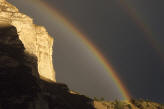|
|
Local Native Americans witnessed the collapse of
Mount Mazama and kept the event alive in their legends. One ancient legend
of the Klamath people closely parallels the geologic story which emerges
from today's scientific research. The legend tells of two Chiefs, Llao of
the Below World and Skell of the Above World, pitted in a battle which
ended up in the destruction of Llao's home, Mt. Mazama. The battle was
witnessed in the eruption of Mt. Mazama and the creation of Crater Lake.
 The
Klamaths revered the lake and the surrounding area, keeping it
undiscovered by white explorers until 1853. That year, on June 12, three
gold prospectors, John Wesley Hillman, Henry Klippel, and Isaac Skeeters,
came upon a long, sloping mountain. Upon reaching its highest point, a
huge, awe-inspiring lake was visible. "This is the bluest lake we've ever
seen," they reported, and named it Deep Blue Lake. But gold was more on
the minds of settlers at the time and the discovery was soon forgotten. The
Klamaths revered the lake and the surrounding area, keeping it
undiscovered by white explorers until 1853. That year, on June 12, three
gold prospectors, John Wesley Hillman, Henry Klippel, and Isaac Skeeters,
came upon a long, sloping mountain. Upon reaching its highest point, a
huge, awe-inspiring lake was visible. "This is the bluest lake we've ever
seen," they reported, and named it Deep Blue Lake. But gold was more on
the minds of settlers at the time and the discovery was soon forgotten.
Captain Clarence Dutton was the next man to make a
discovery at Crater Lake. Dutton commanded a U.S. Geological Survey party
which carried the Cleetwood, a half-ton survey boat, up the steep
slopes of the mountain then lowered it to the lake. From the stern of the
Cleetwood, a piece of pipe on the end of a spool of piano wire
sounded the depth of the lake at 168 differnt points. Dutton's soundings
of 1,996 feet were amazingly close to the sonar readings made in 1959 that
established the lake's deepest point at 1,932 feet.
William Gladstone Steel devoted his life and
fortune to the establishment and management of Crater Lake National Park.
His preoccupation with the lake began in 1870. In his efforts to bring
recognition to the park, he participated in lake surveys that provided
scientific support. He named many of the lake's landmarks, including
Wizard Island, Llao Rock, and Skell Head. Steel's dream was realized on
May 22, 1902 when President Theodore Roosevelt signed the bill giving
Crater Lake national park status. And because of Steel's involvement,
Crater Lake Lodge was opened in 1915 and the Rim Drive was completed in
1918.
Crater Lake National Park is fast approaching its
100th birthday. The celebration of one of our nation's oldest parks is a
testament to the courage and determination of William G. Steel and the
countless others who have been involved in the preservation of this
national treasure. In looking to the future appreciation and preservation
of this park, knowledge of its history and origins are imperative in
keeping with the tradition of Crater Lake's unique past.
In-Depth History
Crater Lake Lodge
More detailed information on the Park's history is
available on the
National Park Service website.
|

